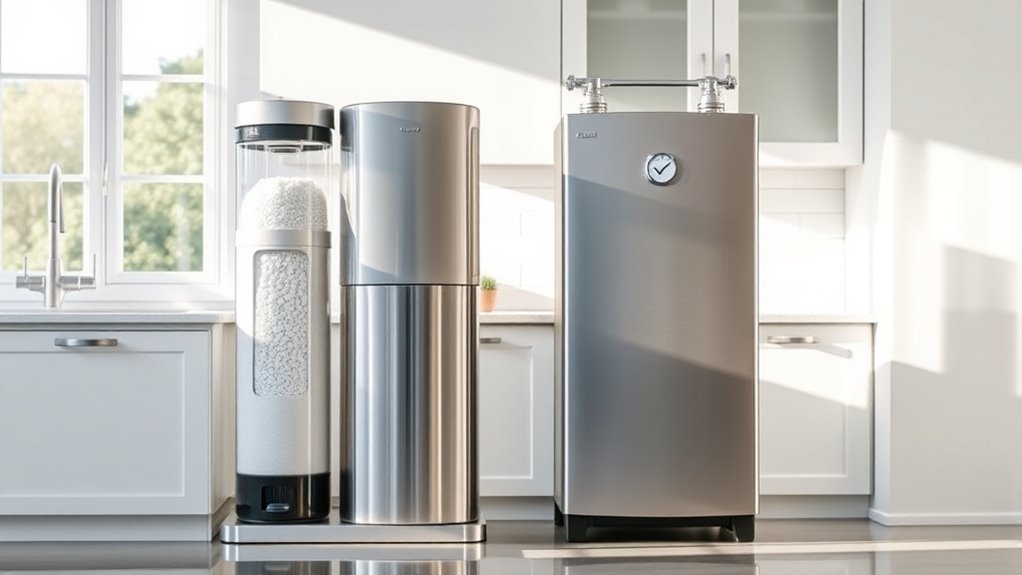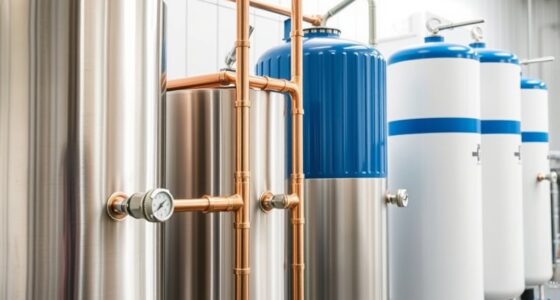To master salt-based vs salt-free water softening in a weekend, start by understanding how each system works—salt-based uses ion exchange to remove minerals, while salt-free alters mineral behavior to prevent scale. Compare costs, maintenance needs, environmental impact, and space requirements. Consider your household’s water quality and health concerns. By analyzing these factors, you’ll quickly see which option suits your needs best—continue exploring to gain detailed insights and make a confident choice.
Key Takeaways
- Understand the fundamental differences: salt-based uses ion exchange, salt-free alters mineral properties, and reverse osmosis removes minerals entirely.
- Compare maintenance needs, costs, and environmental impacts of each system for practical household application.
- Assess water quality requirements and health considerations to choose the most suitable softening technology.
- Study system durability, space requirements, and suitability based on household water hardness levels.
- Review FAQs and expert insights to clarify common misconceptions and optimize system selection in a weekend.
Understanding How Salt-Based Water Softeners Work
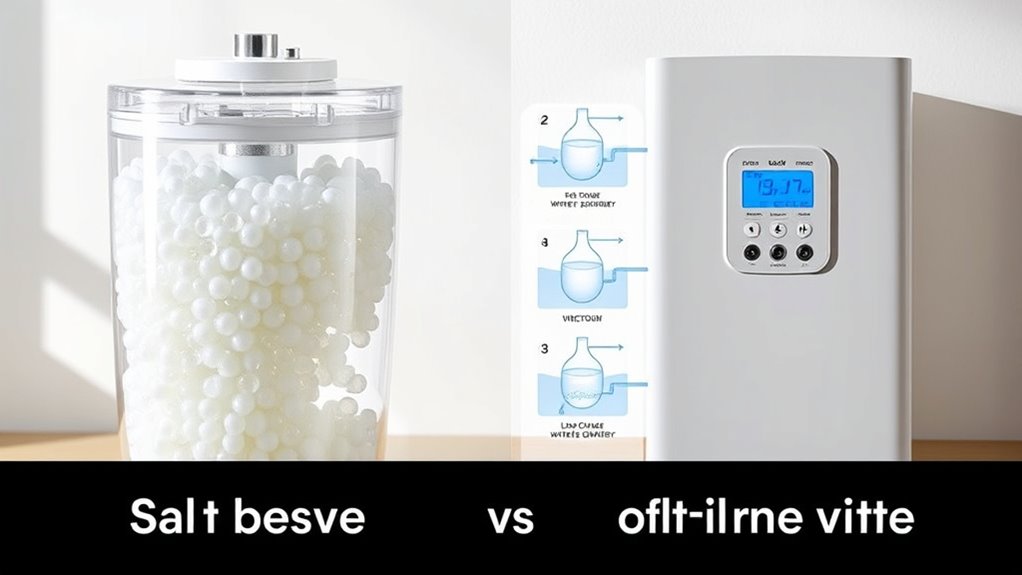
Salt-based water softeners work by removing hard minerals like calcium and magnesium from your water supply through a process called mineral ion exchange. During water softener regeneration, the resin beads inside the tank are cleaned and recharged with sodium ions from the salt. As hard water passes through, calcium and magnesium ions are exchanged for sodium ions, softening the water. This exchange guarantees your plumbing, appliances, and fixtures stay free of scale buildup. When the resin becomes saturated with minerals, the system triggers regeneration, flushing out the mineral ions and replenishing the sodium. This cycle keeps the softener functioning efficiently and provides consistently soft water. Understanding this process helps you appreciate how salt-based systems maintain water quality through continuous mineral ion exchange and regeneration.
Exploring Salt-Free Water Conditioners and Their Mechanisms
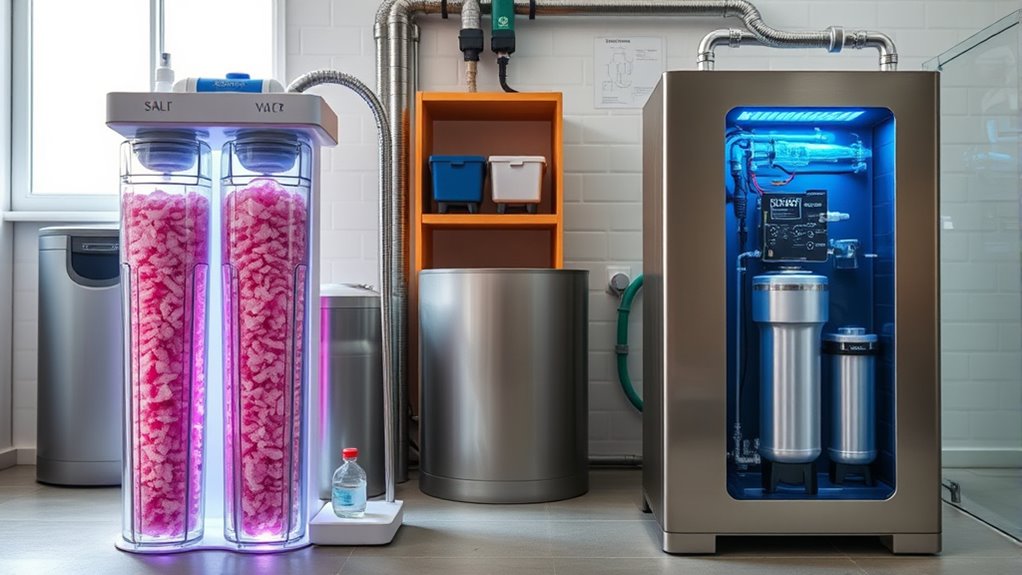
Salt-free water conditioners utilize a different approach to reduce scale buildup without removing minerals from your water. Instead, they alter the way minerals behave through processes like water mineralization and water pH adjustment. These conditioners typically use Template Assisted Crystallization (TAC) or similar technologies to convert hard minerals, such as calcium and magnesium, into harmless, stable crystals. These crystals don’t stick to surfaces, preventing scale formation. Unlike salt-based systems, they don’t strip minerals or add salt, making them more environmentally friendly. Water pH adjustment is also involved, helping to stabilize water chemistry and reduce mineral adhesion. This method maintains mineral content for health benefits while minimizing buildup. Additionally, mineral stabilization plays a key role in preventing mineral deposits from adhering to surfaces, enhancing the effectiveness of salt-free systems. Overall, salt-free conditioners offer a chemical-free, low-maintenance solution that preserves water quality without the need for salt or complex regeneration.
Comparing Costs: Initial Investment and Long-Term Expenses
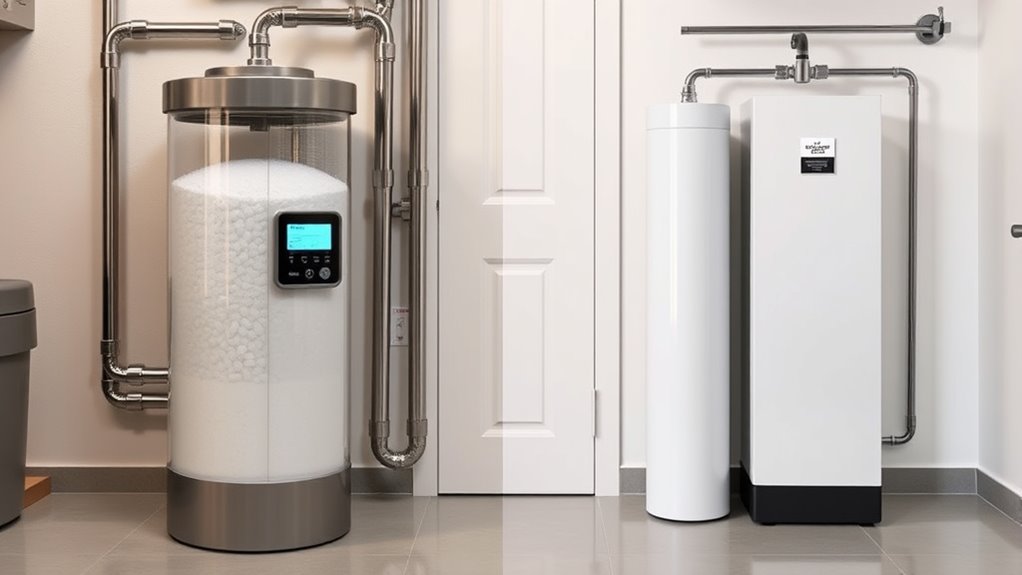
When choosing a water softening system, you need to consider both the upfront costs and ongoing expenses. Salt-based systems often require a higher initial investment but may have lower long-term costs, while salt-free options tend to be cheaper initially but can add up over time. Understanding these financial impacts helps you make the best choice for your budget. Additionally, considering the maintenance requirements of each system can influence overall costs and ease of use.
Initial Purchase vs. Ongoing Costs
Although salt-free systems often have a higher upfront cost, they typically save you money over time by reducing ongoing expenses. Their technology advancements lead to lower maintenance and no need for salt or regeneration. This can boost customer satisfaction by providing consistent water quality with less hassle. To compare costs:
| Initial Purchase | Ongoing Expenses |
|---|---|
| Higher upfront cost | Minimal maintenance costs |
| Technology upgrades | No salt or regeneration fees |
| Longer lifespan | Reduced water and salt use |
While the initial investment might seem steep, the savings on maintenance and consumables make salt-free systems a cost-effective choice in the long run. Plus, their modern technology often results in better customer satisfaction through reliable performance. System longevity also plays a key role in long-term savings, making the initial investment worthwhile.
Long-Term Financial Impacts
While the initial cost of salt-free water softening systems may be higher, their long-term financial benefits often outweigh the upfront investment. A thorough cost comparison shows that salt-free systems typically have lower ongoing expenses, since they don’t require salt or regeneration cycles. Over time, this reduces your maintenance costs and energy bills. Additionally, salt-free systems have a positive environmental impact because they produce less waste and avoid the disposal issues associated with salt-based systems. Proper bedroom maintenance and choosing the right system can further enhance cost savings and system longevity. Though you might pay more initially, the savings in operational and maintenance costs make salt-free options more economical in the long run. By choosing a system with better long-term financial impacts, you’ll enjoy softer water without the recurring expenses or environmental concerns.
Environmental Impact and Sustainability Factors
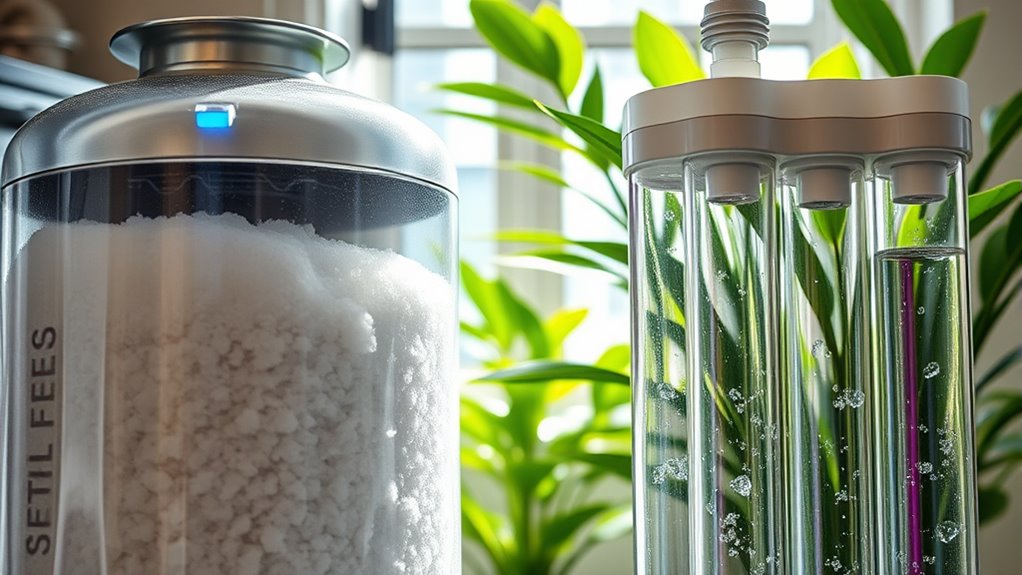
You might be concerned about how your water softener choices affect the environment. Salt-based systems often have a larger ecological footprint due to brine discharge, while salt-free options tend to be more eco-friendly. Considering these factors helps you choose a system that supports sustainability and minimizes environmental harm. Additionally, understanding the environmental impact of different systems can guide you toward more eco-conscious decisions.
Environmental Footprint Comparison
When comparing the environmental footprints of salt-based and salt-free water softening systems, it’s important to contemplate how each impacts sustainability. Salt-based systems often rely on salt, which can lead to increased wastewater and strain recycling programs, especially if not properly managed. They typically consume more energy during regeneration cycles, though some models now use renewable energy sources. Salt-free systems generally have a smaller environmental footprint because they don’t require salt or frequent regeneration, reducing waste and water usage. They also tend to operate more efficiently, using less power and less impact on local ecosystems. Additionally, understanding the sound design principles behind product development can inform more sustainable choices. Overall, salt-free options are more sustainable, especially when paired with renewable energy, making them a better choice for minimizing your environmental footprint.
Eco-Friendly Salt-Free Options
Eco-friendly salt-free water softening options are gaining popularity because they minimize environmental impact and promote sustainability. These eco friendly alternatives use techniques like Template Assisted Crystallization (TAC) or magnetic systems that don’t rely on salt or chemicals. By choosing these sustainable solutions, you reduce the risk of salt runoff, which can harm ecosystems and contaminate groundwater. Salt-free systems also require less energy and generate less waste, making them a greener choice overall. If you’re seeking a solution that’s gentle on the environment while still protecting your plumbing, these options are worth considering. They provide effective water conditioning without sacrificing your commitment to sustainability, helping you lower your carbon footprint while maintaining soft water in your home. Additionally, best beaches often emphasize eco-conscious practices, highlighting the importance of environmentally friendly solutions in all aspects of life.
Maintenance Requirements and Ease of Upkeep
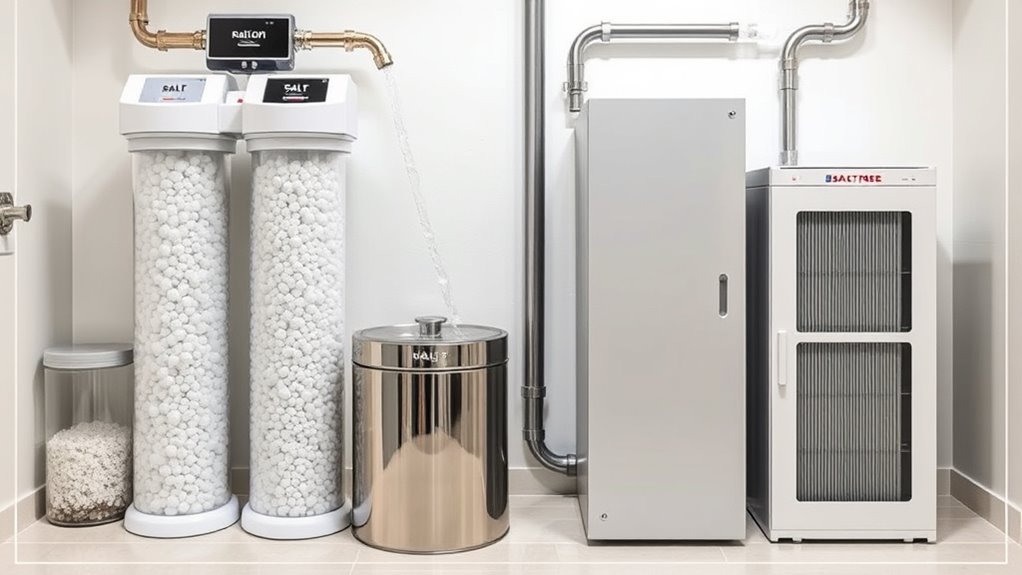
Salt-based and salt-free water softeners differ markedly in their maintenance needs and ease of upkeep. Salt-based systems typically require more frequent maintenance, such as checking salt levels, refilling the brine tank, and periodic regeneration cycles. You’ll need to monitor salt levels regularly and clean the brine tank to prevent buildup. In contrast, salt-free softeners usually need less maintenance, with infrequent filter replacements and minimal cleaning. They don’t require salt or regeneration, making upkeep straightforward. The ease of cleaning for salt-free systems is generally higher, as they lack complex components like resin tanks. Additionally, understanding the family background of the manufacturer can help consumers choose more reliable and trustworthy systems. Overall, if you prefer low-maintenance options, salt-free softeners are easier to keep in good condition, while salt-based units demand more regular attention to stay functioning efficiently.
Effectiveness in Hard Water Treatment and Scale Prevention
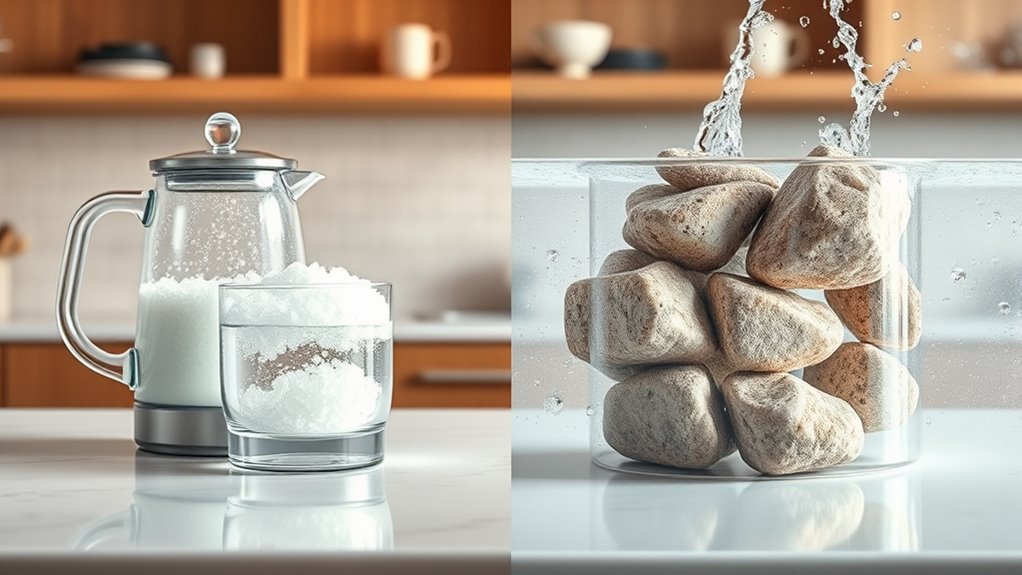
You want to know which system effectively reduces scale and softens water, so you get better results. Salt-based systems typically excel at removing minerals and preventing buildup, while salt-free options may offer limited scale control. Understanding their differences helps you choose the right solution for your water treatment needs. Additionally, considering the beach environment and potential environmental impacts can guide you toward more sustainable options.
Scale Reduction Capabilities
Salt-free water softeners typically prevent scale buildup by altering the minerals’ properties, making them less prone to adhere to surfaces. They achieve this through water mineralization, which changes calcium and magnesium ions into stable, inert compounds that don’t form scale. This process effectively reduces existing scale and prevents new buildup. Unlike salt-based systems, salt-free softeners don’t rely on softener regeneration, so they continue to provide consistent scale prevention without needing salt or frequent maintenance. While they don’t remove minerals from water, they modify their behavior, decreasing the chance of mineral deposits forming on pipes, fixtures, and appliances. Additionally, salt-free systems utilize water mineralization techniques to modify mineral properties, enhancing their ability to prevent scale formation. Overall, salt-free systems excel at controlling scale and maintaining plumbing integrity over time, especially in areas with hard water.
Water Softening Efficiency
When evaluating water softening methods, effectiveness in treating hard water and preventing scale buildup is a key consideration. Salt-based systems, like ion exchange, excel at reducing mineral buildup, improving water pH, and ensuring thorough softening. They effectively replace calcium and magnesium ions, lowering water hardness and minimizing scale formation in appliances and pipes. Salt-free systems, on the other hand, modify mineral behavior through template-assisted crystallization, which prevents mineral deposits without removing hardness ions. While they don’t alter water pH directly, they can still reduce scale buildup over time, though perhaps less aggressively than salt-based methods. Your choice depends on your needs for mineral control and scale prevention, with salt-based systems generally offering higher efficiency in hard water treatment.
Mineral Removal Effectiveness
Salt-based systems are highly effective at removing calcium and magnesium ions, directly reducing water hardness and preventing scale buildup in appliances and pipes. They excel in mineral removal, ensuring your water achieves higher purity levels. These systems work by exchanging hard water minerals with sodium, which keeps scale-causing minerals at bay. To understand their capacity better, see the table:
| System Type | Mineral Removal Efficiency | Scale Prevention |
|---|---|---|
| Salt-based | Very High | Excellent |
| Salt-free | Moderate | Limited |
| Reverse Osmosis | Very High | Excellent |
Choosing the right system depends on your water quality goals and maintenance preferences for ideal mineral removal and water purity.
Health and Safety Considerations for Your Family
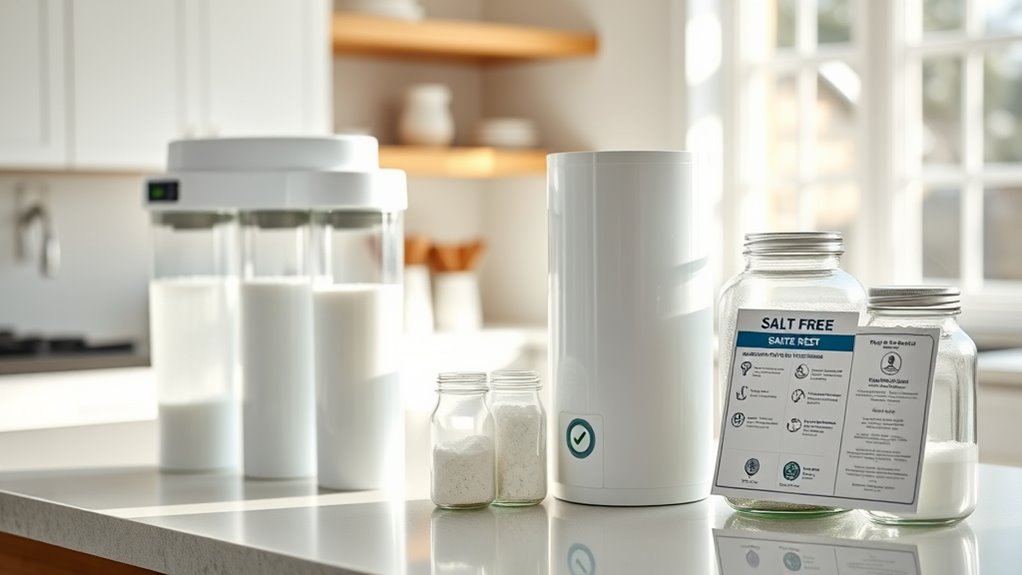
Choosing the right water softening system is crucial for your family’s health and safety, as it directly impacts the quality of the water you consume daily. Salt-based systems often rely on chemical filtration, which can introduce sodium or other additives into your water, potentially affecting those with health concerns like hypertension. Salt-free systems, on the other hand, preserve essential minerals through water mineralization, maintaining beneficial health properties without adding chemicals. It’s important to contemplate how each system influences water safety, especially for vulnerable family members. By understanding these differences, you can select a system that minimizes health risks while ensuring safe, high-quality water for drinking and cooking. Your choice should prioritize health, safety, and the specific needs of your household.
Space and Installation Requirements for Both Systems
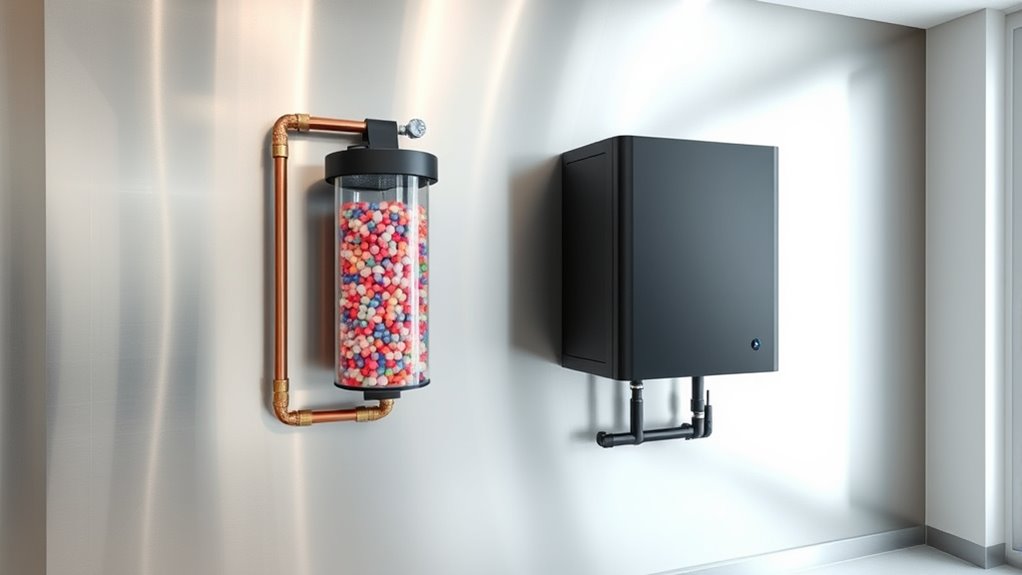
The installation space and setup requirements can vary considerably between salt-based and salt-free water softening systems. Salt-based systems typically need a dedicated, accessible area for the tank and brine chamber, often requiring more space due to their larger size. You’ll need to take into account the proximity to your main water line and ensure enough room for maintenance and refilling. Salt-free systems are generally more compact and can often be installed directly on the main line or under a sink, making them ideal for tight spaces. When evaluating installation considerations, think about the available space, accessibility, and whether the system’s size fits your home’s layout. Proper planning ensures your system runs smoothly without disrupting your daily routines.
Longevity and Durability of Salt-Based Vs Salt-Free Options
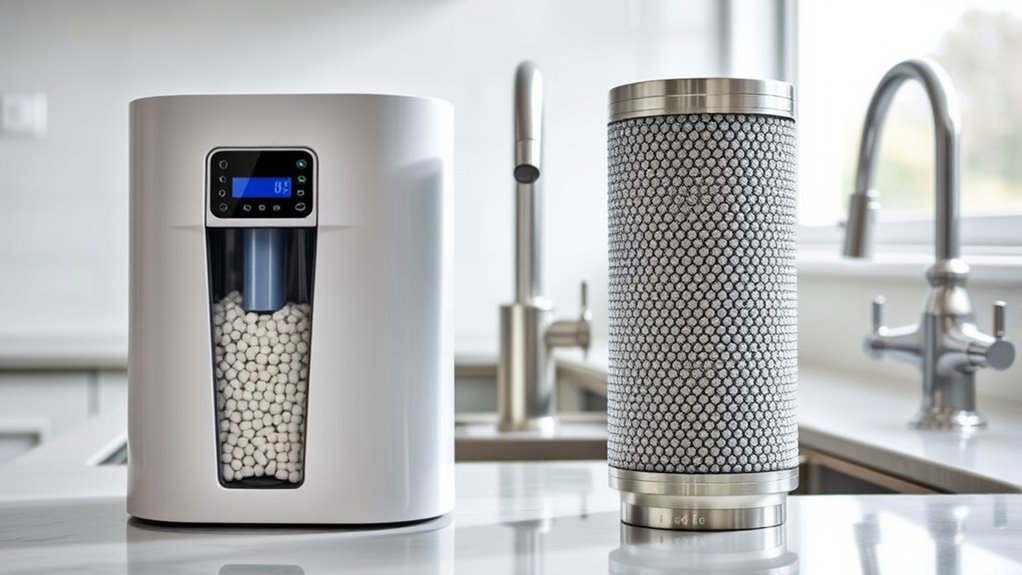
When considering how long your water softening system will last, durability and lifespan are key factors. Salt-based systems generally have a longer system lifespan because they actively remove minerals like calcium and magnesium, which cause scale buildup. Their durability depends on water mineral content; harder water can wear down components faster. Salt-free options, while low-maintenance, tend to have a shorter lifespan due to their reliance on template-assisted crystallization, which can degrade over time. However, they’re less prone to corrosion from salt and chemicals. Overall, if your water has high mineral content, a salt-based system may last longer with proper maintenance. Salt-free systems are durable but may need replacement sooner, especially in areas with extremely hard water.
Making an Informed Choice: Which Softener Fits Your Home and Budget
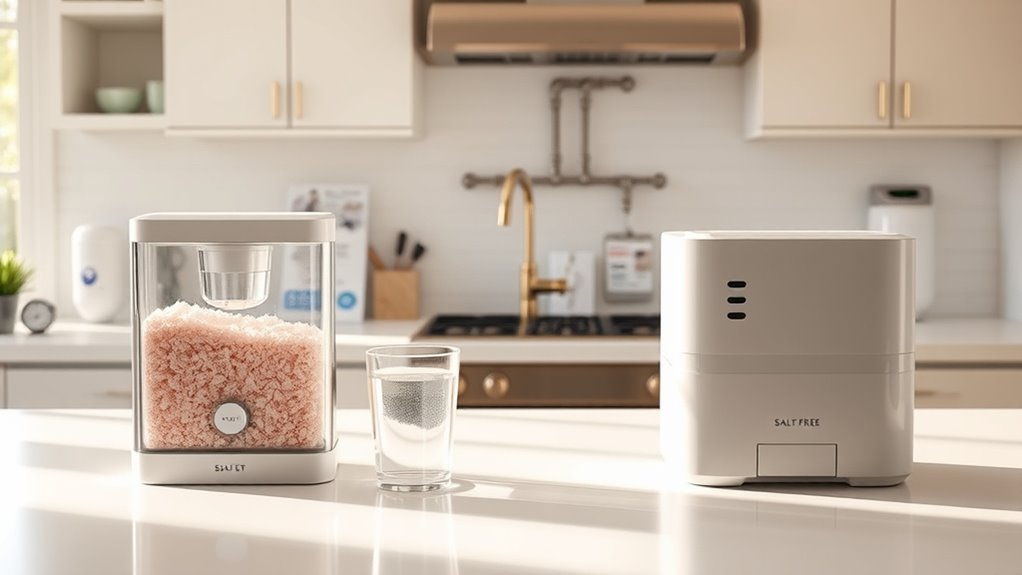
Deciding between salt-based and salt-free water softeners depends on your home’s specific needs and your budget. Salt-based systems typically require regular water softener regeneration, which involves salt consumption, making ongoing costs a consideration. If you want a softener that handles heavy mineral buildup and minimizes maintenance, a salt-based option might be best. Conversely, salt-free softeners use a different process, often with lower operating costs and no salt needed, fitting tight budgets. Think about your water hardness level, household size, and long-term expenses when choosing. Salt consumption and the frequency of water softener regeneration will impact your costs and convenience. By understanding these factors, you can select a softener that balances performance, affordability, and your household’s specific water treatment needs.
Frequently Asked Questions
Can Salt-Free Systems Remove Existing Scale Buildup Effectively?
Salt-free systems aren’t designed for effective scale removal once buildup has occurred. They work by preventing new scale but don’t dissolve existing deposits. You’ll need to perform maintenance more frequently or consider a system that includes a descaling function for ongoing scale removal. Regular cleaning and descaling are essential to keep your system efficient and reduce maintenance frequency, especially if you’re dealing with significant existing scale buildup.
Are There Any Health Risks Associated With Salt-Based Water Softeners?
You might have health concerns with salt-based water softeners, especially if you’re on a low-sodium diet, since they add sodium to your water. Additionally, there’s an environmental impact due to the brine discharge, which can harm local ecosystems. While generally safe for most, it’s wise to take into account these health and environmental factors before choosing a salt-based system, and consult with a professional if you have specific health issues.
How Do Salt-Based and Salt-Free Systems Impact Septic Systems?
While salt-based systems can subtly influence septic system health by increasing salt levels, they generally don’t cause major issues if properly maintained. Salt-free options tend to have a gentler environmental impact, supporting septic systems’ natural function. Your choice impacts not only your household but also the environment; consider how each system aligns with your septic system’s needs and the broader ecosystem to make an informed decision.
What Are the Warranty Options Available for Both System Types?
You should check the warranty coverage offered by manufacturers for both systems. Most salt-based softeners come with warranties that cover system components and tank integrity, guaranteeing better system longevity. Salt-free systems often have limited warranties, but some manufacturers provide extended coverage. Understanding these options helps protect your investment and guarantees reliable performance. Always review the warranty details before purchasing to ensure you get the best protection for your softening system.
Do Local Regulations Restrict the Use of Salt-Based Water Softeners?
Local regulations can restrict the use of salt-based water softeners due to regulation compliance and installation restrictions. You should check with your local authorities or water management agencies to determine if any bans or limitations apply in your area. These rules aim to protect the environment and water quality, so understanding them guarantees you choose a softening system that’s compliant and suitable for your property.
Conclusion
Choosing between salt-based and salt-free water softeners is like picking the right tool for a job—you need the one that fits your needs best. By understanding how each system works, their costs, and maintenance, you’ll be able to make an informed decision. Remember, a wise choice today can save you headaches tomorrow—like planting a seed now for a healthier, more efficient home in the future. Trust your research, and your home will thank you.
